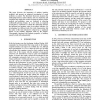Free Online Productivity Tools
i2Speak
i2Symbol
i2OCR
iTex2Img
iWeb2Print
iWeb2Shot
i2Type
iPdf2Split
iPdf2Merge
i2Bopomofo
i2Arabic
i2Style
i2Image
i2PDF
iLatex2Rtf
Sci2ools
ICAD
2004
2004
How to Tackle Auditory Interface Aesthetics: Discussion and Case Study
This paper discusses the importance of auditory interface aesthetics and presents an empirical investigation of sound aesthetics in context. The theoretical discussion examines the relationship between sound aesthetics and user satisfaction and concludes that, despite the creation of numerous auditory design methods and guidelines, none are dedicated to achieving aesthetically pleasing designs. In a case study, an empirical investigation is conducted to evaluate the relationship between the functional and aesthetic value of an auditory interface. By investigating two different tasks, this study demonstrates that the nature of the tasks allocated to subjects has a significant impact on the aesthetic judgments made by the subjects. Consequently, functional and aesthetic properties of auditory cannot be dealt with independently.
| Added | 31 Oct 2010 |
| Updated | 31 Oct 2010 |
| Type | Conference |
| Year | 2004 |
| Where | ICAD |
| Authors | Grégory Leplâtre, Iain McGregor |
Comments (0)

